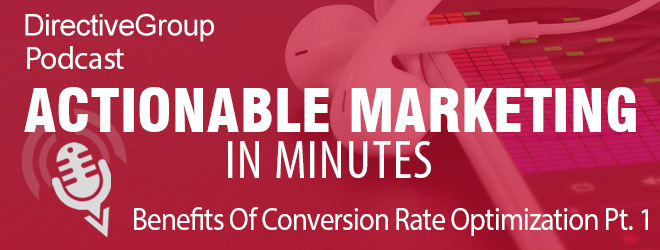In this episode of Actionable Marketing In Minutes we discuss the benefits of conversion rate optimization in the first of a three part series.
Use the player below to listen to this episode, or the download link to load it on your device for listening later. You can also find our RSS feed by clicking here, or subscribe by email in the sidebar to the left.
Download our Marketing To Millennials eBook here!
Not able to listen? Why not read the episode transcript below:
Problem:
No doubt, you’ve heard the term conversion and have a basic idea of what it means but to ensure that we’re all on the same page, let me define it for you. Specifically, a conversion is when a user comes to your site and does what you what him or her to do. That could be one of a number of actions, such as signing up for a newsletter, or creating an account. It could be making a purchase or downloading an app.
So, Conversion Rate Optimization – or CRO – is basically improving the performance of your website by utilizing a structured and systematic approach driven by insights derived from both analytics and user feedback. It is defined by your own unique goals.
Quite a few businesses are under the mistaken impression that the goal is simply to get as many users on their site or fans or likes on their social media channel as possible. But, while it may feel good to see a lot of visitors, that’s not your goal. You need qualified users who have a need only you can fill or a pain that only you can satisfy.
Today, I want to discuss a few things you’ll want to focus on in your quest to increase your conversion rate. These are all items that illustrate what users are doing once they get to your site. By seeing, measuring and analyzing their actions, you will be able to pinpoint trouble spots, make course adjustments and then increase your conversion rate – which of course, will increase your bottom line. Now, that’s your goal!
Solution:
The first thing you’ll want to do is to figure out what exactly is your current conversion rate. To do that, simply divide your total conversions by the number of people who visited your site. Remember, conversions are the people who did what you wanted them to do. So, if 500 came to your site and 10 signed up for your newsletter, your conversion rate is 2%. That’s a number you’ll definitely want to increase.
You’ll also want to find out what your Bounce Rate is; what your Exit Rate is; what is the average time on your site; and what your average page views are. You’ll find these numbers at the analytic service of your choice, such as Google Analytics or KISSmetrics.
Let’s look at those data points a little more closely.
1. Your bounce rate is the percentage of people who leave after viewing only one page. It means people aren’t finding what they expected, so leave immediately. Needless-to-say, you do not want a high bounce rate.
2. Your exit rate lets you know the last page viewed before leaving the site. If a particular page has a high exit rate, you’ll need to study that page to figure out why.
3. Your average time on site – also referred to as an engagement metric – gives you an idea of exactly what it says it does. It tells you how much time visitors are spending on your site.
4. Your average page views – also an engagement metric – tells you how many pages an average visitor views before leaving. If it appears that a visitor is looking at a good number of pages, but aren’t converting, you need to figure out why. Perhaps a lack of clarity regarding your conversion funnel.
Benefits:
So, you see, it doesn’t matter how many people visit your site. What matters is what they do once there and if they even stick around long enough to figure out what you want them to do. The bottom line is you want them to convert – to take action.
Finding and analyzing the numbers we’ve just discussed will help you better form an educated hypothesis about your site’s conversion success – or lack thereof.
In our next segment of this series I want to drill down a bit into this topic a little more. Join us next time as we discuss the next segment in this series entitled Conversion Optimization: Split Testing vs. Multivariate testing.
We hope you’ve found this information helpful. Please connect with us on Twitter @DirectiveGroup or on LinkedIn. Let us know what you think and what you’d like to hear about next. And if you like our podcasts please share with your networks using hashtag #actionablemarketing.
Podcast: Play in new window | Download (Duration: 5:31 — 2.3MB) | Embed
